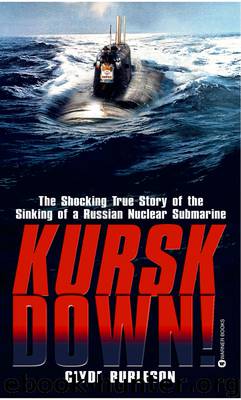Kursk Down by Clyde Burleson

Author:Clyde Burleson [BURLESON, CLYDE]
Language: eng
Format: epub
Tags: HIS027000
ISBN: 9780446554565
Publisher: Grand Central Publishing
Published: 2008-12-13T16:00:00+00:00
16 August 2000—0800 Hours—Barents Sea
The fourth day dawned with a prediction of more storms. While that was disappointing, spirits rose with the arrival of another DSRV. This was a welcome addition to the fleet because the reliable AS-34 needed to be removed from the water and swung aboard the Rudnitsky for essential maintenance tasks. Repairs would enable the sub to be used for a longer period when placed back into service.
Crane lines were made fast to AS-34. As she was lifted from the sea she swung in the wind, violently slamming her hull into the ship. Men grabbed cables dangling from the boat and struggled to stabilize the DSRV before the minisub hit again. It was too late. The damage had been done.
A quick inspection revealed antennas required for sonar and electronic sensing had been broken. There were no replacements. Fixes were improvised and the submersible was able to return to limited service.
While rushed repairs were being made to AS-34, other plans were evaluated. One concept was to lay water-filled pontoons alongside the Kursk hull. These floats would be connected by web belts. Compressed air could then be piped into the cylinders, forcing the water out. The pontoons would rise and lift the giant boat to the surface. The procedure was ruled more a salvage operation than a crew-rescue program, so the idea was discarded.
Another concept called for connecting electrical power cables and an oxygen hose to the submarine. As there were no connectors on the Kursk’s hull suitable for such use, the necessary hardware would have to be fabricated and then attached by divers. The length of time required to accomplish this ruled out the project.
By this point, different types of Deep Sea Rescue Vehicles had made more than ten attempts to dock and connect with the rear escape hatch. All had failed. The DSRV crews were willing to continue. There was little hope, however, that they would be able to perform a successful rescue. Even so, these men were the most effective option the Russian Navy possessed.
Rumors sprang from failures. One held that the Kursk lay on the bottom with a 60-degree list and her bow down at an angle of 20 degrees. This position, tail high and leaning to one side, coupled with a swift current over the hull, suggested the need for help.
At 1500 hours, President Vladimir Putin, still on holiday in the Black Sea resort of Sochi, described the situation as “critical.”
Shortly afterward, Deputy Prime Minister Ilya Klebanov was quoted as saying there were no signs of life on the sub—this despite recent reports of hammering on the inside of the hull.
Four days had elapsed. It was time for a different approach. After due consultation, President Putin, acting in his capacity as supreme commander-in-chief, passed the order for Navy head Admiral Vladimir Kuroyedov to accept foreign assistance. Kuroyedov’s team acted immediately to arrange help from both Britain and Norway.
This presidential action was a political masterstroke. Being ordered to accept outside aid allowed the Navy to continue its effort while negotiations for help were under way.
Download
This site does not store any files on its server. We only index and link to content provided by other sites. Please contact the content providers to delete copyright contents if any and email us, we'll remove relevant links or contents immediately.
Small Unmanned Fixed-wing Aircraft Design by Andrew J. Keane Andras Sobester James P. Scanlan & András Sóbester & James P. Scanlan(32767)
Navigation and Map Reading by K Andrew(5135)
Endurance: Shackleton's Incredible Voyage by Alfred Lansing(4722)
And the Band Played On by Randy Shilts(2169)
The Box by Marc Levinson(1967)
Top 10 Prague (EYEWITNESS TOP 10 TRAVEL GUIDES) by DK(1963)
Wild Ride by Adam Lashinsky(1952)
The Race for Hitler's X-Planes: Britain's 1945 Mission to Capture Secret Luftwaffe Technology by John Christopher(1838)
The One Percenter Encyclopedia by Bill Hayes(1811)
Trans-Siberian Railway by Lonely Planet(1729)
Girls Auto Clinic Glove Box Guide by Patrice Banks(1710)
Bligh by Rob Mundle(1677)
Looking for a Ship by John McPhee(1651)
Good with Words by Patrick Barry(1641)
Batavia's Graveyard by Mike Dash(1634)
TWA 800 by Jack Cashill(1626)
Fighting Hitler's Jets: The Extraordinary Story of the American Airmen Who Beat the Luftwaffe and Defeated Nazi Germany by Robert F. Dorr(1614)
Troubleshooting and Repair of Diesel Engines by Paul Dempsey(1578)
Ticket to Ride by Tom Chesshyre(1568)
